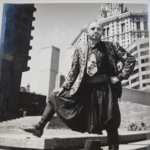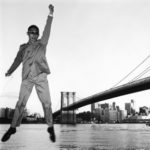Love Among the Ruins: 56 Bleecker Gallery and Late 80s New York is on view through October 7 at Howl! Happening, with a closing performance by John Kelly and Joseph Keckler. Co-curated by Susan Martin, Maynard Monrow, and Bill Stelling, the exhibition features the works of over sixty artists and writers involved with the 1980s East Village arts scene, including Visual AIDS artist members Nicolas Moufarrege, Tseng Kwong Chi, and Martin Wong. Here, Visual AIDS summer intern Didi Chang-Park reflects on the exhibition and collectively interviews the exhibition's curators.
Rather than approaching the late 80s as a site for academic critique or historical analysis, Love Among the Ruins centers love and loss — emotions that epitomize the intensity and lasting relevance of the time. The show seeks to revive the energy and camaraderie of the artists and friends of 56 Bleecker, who worked together to flourish through difficult times.
Considering the show’s avowed focus on love and loss, I am particularly curious to see how Love Among the Ruins might avoid being overcome by nostalgia, and how it might strike its relevance with contemporary conversations around art and activism. The exhibition tells this story through its artworks and accompanying textual materials, including the exhibition catalog, comprising essays and poems by thirteen different voices, and a manuscript of Dean Rolston’s memoir Remembering Dying, to be published for the first time in association with the show.
The vivacity, intelligence, and diversity of experience represented in Love Among the Ruins compellingly links the process of mourning the past with the need to sharply interrogate the present. Rolston's description of his changing embodiment and sexuality while dying from AIDS is exceedingly relevant to read in an era where youthfulness and superficial perfection of the body continue to be valorized in gay culture. Ariana Reines’ poem “The Pilgrims’ Progress” gives voice to younger generations who do not personally know the victims of the past, yet strongly feel their impact, as she questions how to write about, process, and memorialize histories which she did not experience firsthand.
With these impressions in mind, I’ve approached the three curators, Susan Martin, Maynard Monrow, and Bill Stelling on the process of organizing Love Among the Ruins.
Didi Chang-Park: In reading through the textual materials pertaining to the exhibition — the catalog, and Dean Rolston’s memoir, I was particularly struck by the diversity of voices and approaches to the subject matter of the exhibition. How did you go about finding and compiling these texts? Did it happen organically, through shared friendships, or did you find yourself consciously seeking out ‘diverse’ voices?
Susan Martin, Maynard Monrow, Bill Stelling: Both through shared friendships and by seeking out specific voices. In fact, it was a discussion with a group of 30 year olds and their relationship to AIDS that spurred the idea of the exhibition. They had a hard time wrapping their minds around what it must have been like emotionally to live with so much loss, especially now that there are effective treatments. We knew we wanted to open up the conversation to a younger generation and sought out people like Arianna Reines for the catalogue and Alex Fialho of Visual AIDS for the panel. We built consensus around the authors by discussing how to express the gestalt of love and loss which characterized that period by providing a number of different ways to enter the stream of the exhibition: the retrospective, the catalogue, Dean’s memoir, and the events.
DCP: What was the process of collaborating like, considering that there are three of you? How did you coordinate the curation of text with the curation of visual material?
SM, MM, BS: Our collaboration went wonderfully. It was all about listening to each other, discussion, and staying open and in process without having fixed expectations. Bill and Maynard had deep knowledge of the art and artists and were able to call up on the spot more than 50 names of creators who worked with 56 Bleecker. Maynard and Susan were old, dear friends and together were Dean’s caretakers and companions in his last years. Susan and Bill only met through this project. Bill and Maynard curated most of the show, for example, and Susan managed the publication of the catalogue and Dean’s Memoir. The magic was distilled in the reciprocity and energy created by our collaboration, and the tremendous response from the artists. And, of course, collaboration always results in energy greater than the sum of its parts.
DCP: I am curious to hear more about the inclusion of Nicolas Moufarrege in the show. As a Visual AIDS intern, I first became familiar with him while reading Visual AIDS’ recent DUETS publication on his work. It was fascinating to see what he brought to the 80s gallery scene both as a visual artist and an incisive arts writer, especially considering his status as an ethnic outsider, born in Egypt and raised in Beirut. Can you speak to Nicolas’s work in the context of the show?
SM, MM, BS: The work that we’re exhibiting is a very early and unique piece by the artist, not one of his more typical needlepoint works. It’s a visual reference to him as a writer. Nicolas was critical in documenting the East Village art scene at its inception and we felt that because of his association with many of the artists in the show, it would be appropriate to include this specific piece.
DCP: To what extent was the concept, or perhaps the accusation, of nostalgia on your minds as you thought about organizing this show? I’m thinking in particular about the “Your Nostalgia Is Killing Me” poster by Vincent Chevalier and Ian Bradley Perrin, which sought to critique the canonization of late 80s and early 90s activist work surrounding AIDS. Of course, Love Among the Ruins isn’t only about AIDS, or activism, but because there have been exhibitions centering 80s artwork in NYC for quite some time now, I’m curious to hear your approach to curating a show on the 80s that is still fresh, relevant, and unique.
SM, MM, BS: We see love and loss as particularly relevant today. And so is the work on view: it feels fresh and laden with content and critique. The show is about evoking an emotional response, opening the heart. It was never meant as a stroll down memory lane. The younger people we talk to seem extremely interested in this period and there’s still a great deal to learn from it. History is a continuum, it informs where we are here and now. There’s no one, right way to be an activist today, nor was there then, really. We did our heavy lifting back in the day, each in our own way. We consider love a revolutionary act—irreverently and unabashedly appropriate for all times. We don’t have an agenda. The show is more a visceral response to that period rather than a political one. As Robert Browning says in his poem, Love Among the Ruins: Love is best.
DCP: Love Among the Ruins includes a lot of artists, sixty-three if I counted correctly. I admire this attempt to include more rather than less. How did you manage to balance cohesion with multiplicity? And more generally, what was the most difficult experience you had with curating Love Among the Ruins? What was the most rewarding?
SM, MM, BS: The exhibition is a retrospective of as many of the artists as we could find. We weren’t into being gatekeepers or “editing” history. We wanted to be inclusive and not make arbitrary divisions. When we started approaching people, there was an incredible outpouring of excitement, collaboration, and good will among artists. And, of course, all of them were affected deeply by the AIDS epidemic. The show is a mosaic of diverse works that we think speaks to the artistic concerns of the artists who showed at 56 Bleecker and beyond. Getting to know each other, as people and curators, was part of the pleasure. And reconnecting with old friends. Community! Who could ask for more?










